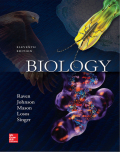
Concept explainers
Which of the following is NOT found in topsoil?
a. Humus
b. Bedrock
c. Bacteria
d. Air
Introduction:
The soil is an important part of the Earth. The soil layer of the Earth is called the pedosphere, which plays a vital role in Earth’s atmosphere. It provides medium for plant growth, water storage, and provides space for organisms to live. The soil composed of 50% solids that has minerals and organic matter, and other 50% pores are filled with water and gas.
Answer to Problem 1U
Correct answer:
The soil consists of humus, microorganisms including bacteria, and the pore space between the soil particles have air, however, the topsoil lack bedrock. Therefore, option b. is correct.
Explanation of Solution
Reason for the correct statement:
The soil is formed by the weathering of rocks and is the outermost layer of the crust of the Earth. It is comprised of rocks, sand, silt, clay, humus, and other organic matter. There are different layers of soil. The topsoil is the topmost layer of the soil. The topsoil is comprised of mineral particles, microorganisms, humus, sand, clay, silt, air, and water.
Option b. is given as "bedrock".
As “the bedrock is the innermost layer of the soil and is NOT found in the topsoil”, it is the right answer.
Hence, option b. is correct.
Reasons for the incorrect statements:
Option a. is given as “humus”.
The humus can be defined as the partially digested and decomposed organic matter. It is found in the topsoil. Therefore, it is a wrong answer.
Option c. is given as “bacteria”.
The topsoil consists of living organisms including bacteria, fungi, and other microorganisms. Therefore, it is a wrong answer.
Option d. is given as “air”.
The air in the topsoil is present in the pore space present between the particles of the soil. Therefore, it is a wrong answer.
Hence, options a., c., and d. are incorrect.
Conclusion:
The soil is formed by the weathering of rocks. It has several layers, the topmost of it is known as the topsoil. The topsoil is comprised of sand, silt, clay, air, humus, microorganisms and roots of the plants.
Want to see more full solutions like this?
Chapter 38 Solutions
EBK BIOLOGY
- What is behavioral adaptarrow_forward22. Which of the following mutant proteins is expected to have a dominant negative effect when over- expressed in normal cells? a. mutant PI3-kinase that lacks the SH2 domain but retains the kinase function b. mutant Grb2 protein that cannot bind to RTK c. mutant RTK that lacks the extracellular domain d. mutant PDK that has the PH domain but lost the kinase function e. all of the abovearrow_forwardWhat is the label ?arrow_forward
- Can you described the image? Can you explain the question as well their answer and how to get to an answer to an problem like this?arrow_forwardglg 112 mid unit assignment Identifying melting processesarrow_forwardGive only the mode of inheritance consistent with all three pedigrees and only two reasons that support this, nothing more, (it shouldn't take too long)arrow_forward
- Oarrow_forwardDescribe the principle of homeostasis.arrow_forwardExplain how the hormones of the glands listed below travel around the body to target organs and tissues : Pituitary gland Hypothalamus Thyroid Parathyroid Adrenal Pineal Pancreas(islets of langerhans) Gonads (testes and ovaries) Placentaarrow_forward

 Biology: The Dynamic Science (MindTap Course List)BiologyISBN:9781305389892Author:Peter J. Russell, Paul E. Hertz, Beverly McMillanPublisher:Cengage Learning
Biology: The Dynamic Science (MindTap Course List)BiologyISBN:9781305389892Author:Peter J. Russell, Paul E. Hertz, Beverly McMillanPublisher:Cengage Learning Biology 2eBiologyISBN:9781947172517Author:Matthew Douglas, Jung Choi, Mary Ann ClarkPublisher:OpenStaxBasic Clinical Lab Competencies for Respiratory C...NursingISBN:9781285244662Author:WhitePublisher:Cengage
Biology 2eBiologyISBN:9781947172517Author:Matthew Douglas, Jung Choi, Mary Ann ClarkPublisher:OpenStaxBasic Clinical Lab Competencies for Respiratory C...NursingISBN:9781285244662Author:WhitePublisher:Cengage Biology: The Unity and Diversity of Life (MindTap...BiologyISBN:9781337408332Author:Cecie Starr, Ralph Taggart, Christine Evers, Lisa StarrPublisher:Cengage Learning
Biology: The Unity and Diversity of Life (MindTap...BiologyISBN:9781337408332Author:Cecie Starr, Ralph Taggart, Christine Evers, Lisa StarrPublisher:Cengage Learning





